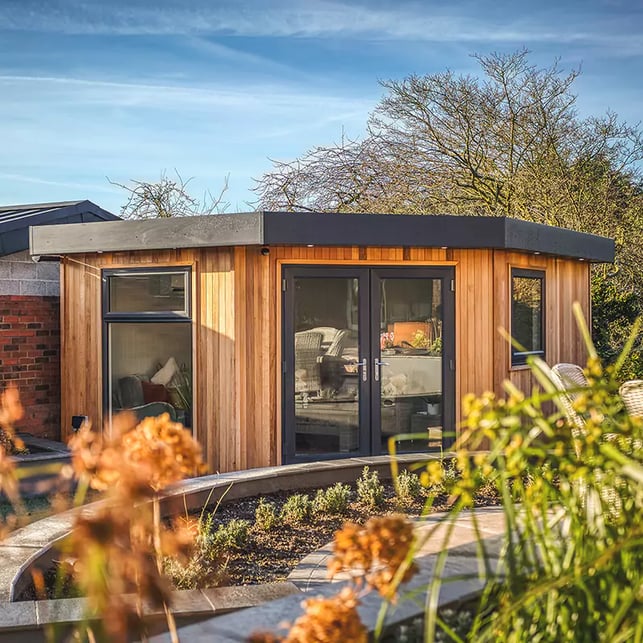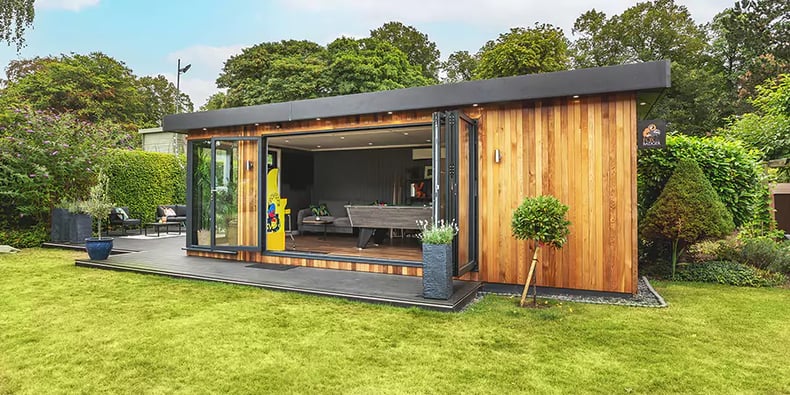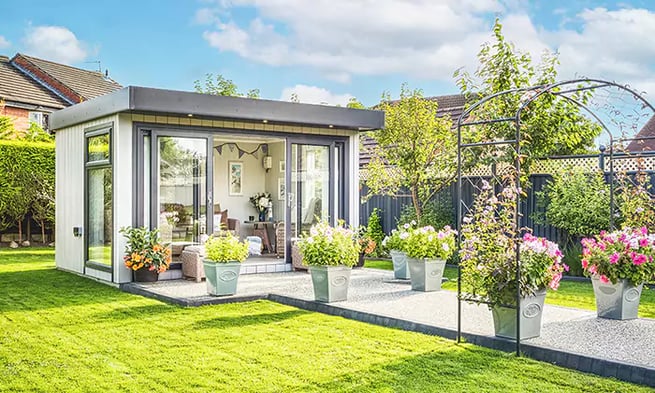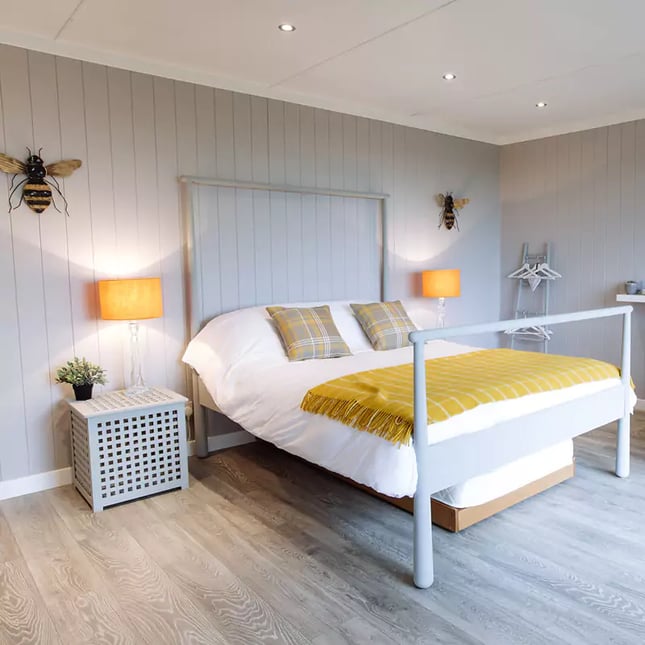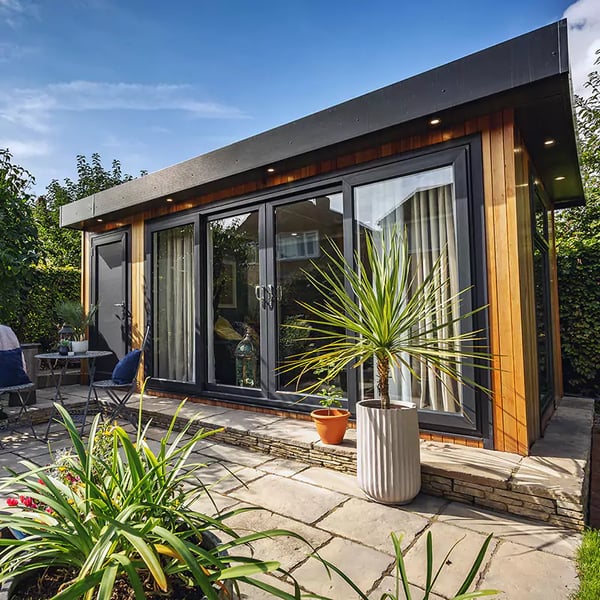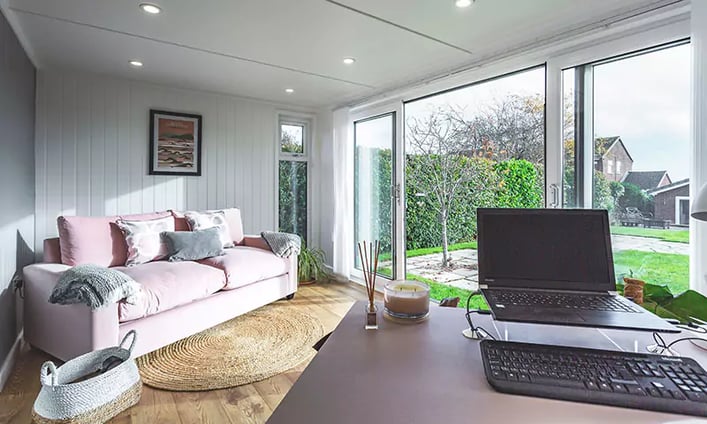
Insulating Your Garden Room: A Beginner's Guide
Garden rooms have increasingly become popular extensions of our living spaces, offering a tranquil retreat or a dedicated area for work, hobbies, and relaxation. However, to truly enjoy these benefits year-round, proper insulation is key. Insulation transforms a garden room from a seasonal space to a comfortable, energy-efficient haven regardless of the weather outside. This guide will introduce you to the basics of insulating your garden room, ensuring it's a cosy, welcoming space throughout the year.
For bespoke, luxury, fully insulated garden rooms contact Cabin Master.
Why Insulate Your Garden Room?
Insulating your garden room is not just about keeping it warm in the winter and cool in the summer; it's about transforming the space into a functional part of your home. Proper insulation offers several benefits that extend beyond mere comfort.
Firstly, it significantly improves the energy efficiency of the space, reducing the need for heating in the winter and cooling in the summer, thereby lowering energy costs. Additionally, insulation helps prevent condensation and mould growth, which are common issues in spaces that experience temperature fluctuations.
This makes your garden room a healthier environment for work or relaxation. Insulating your garden room also enhances soundproofing, providing a quieter space that's secluded from the noise of the outside world. Whether you're using your garden room as a home office, a studio, or a leisure room, insulation ensures it's a versatile space that meets your needs all year round.
Choosing the Right Insulation for Your Garden Room
Selecting the ideal insulation for your garden room is key to creating a cosy, energy-efficient retreat. Here we’ll discuss some of the most common types of insulation for a garden room.
Fibreglass Insulation
Fibreglass insulation is a common choice for garden rooms due to its affordability and effectiveness in insulating both walls and roofs. Its popularity stems from its ability to fit into a wide range of spaces, offering significant improvements in thermal performance without a substantial investment.
However, when working with fibreglass, it's important to exercise caution due to the irritant nature of its fibres. Proper safety gear, such as gloves, goggles, and masks, should be used during installation to avoid skin irritation and respiratory issues.
Cellulose insulation
Cellulose insulation, derived from recycled paper products, stands out for its eco-friendly attributes and excellent thermal performance. It's particularly well-suited for areas that require dense packing, making it a great choice for filling in cavities and ensuring no spaces are left uninsulated.
The use of cellulose not only enhances the energy efficiency of a garden room but also contributes to a lower environmental impact, aligning with green building practices. Its effectiveness and sustainability make it a compelling option for those looking to insulate their garden room with an eye towards environmental responsibility.
Foam Board or Rigid Foam
Foam board or rigid foam insulation offers a high insulation value with comparatively minimal thickness, making it an ideal solution for floors and spaces where conserving room is crucial. This type of insulation provides a robust barrier against heat transfer, ensuring that a garden room remains comfortable throughout the year while maintaining its spatial integrity.
Due to its rigid nature, foam board can be easily cut and fitted into specific areas, offering a versatile and effective insulation solution that is particularly beneficial in maximising usable space within a garden room.
Spray Foam
Spray foam insulation is renowned for its superior air sealing properties and high R-values, delivering unparalleled energy efficiency. Its ability to expand and fill even the smallest gaps makes it an excellent choice for creating airtight seals in hard-to-reach areas, such as around windows, doors, and in irregular spaces.
While spray foam offers exceptional insulation performance, it is typically more expensive than other options and requires professional installation. Despite the higher initial cost, its long-term benefits in terms of energy savings and improved comfort can make it a worthwhile investment for those looking to optimise the insulation of their garden room.
Considerations When Choosing Insulation
Assess Your Needs
Begin by evaluating the primary function of your garden room. Is it a cosy retreat, a home office, a garden gym, or a camping cabin for year round use? The intended use will dictate your insulation requirements.
For instance, a garden office might need higher-grade insulation for comfort and energy efficiency, especially if you plan to use it in colder months. Consider the local climate and weather patterns, as they will significantly influence the type of insulation you need. Areas with extreme temperature variations demand insulation with high R-values to maintain a comfortable indoor environment.
If you’re considering an insulated bespoke garden room, Cabin Master offers a free design service with no obligation, so you can get a clear vision on what your dream garden room could look like.
Local Building Regulations and Standards
Familiarise yourself with local building codes and regulations regarding insulation. Different areas may have specific requirements for R-values, the measure of thermal resistance, to ensure that buildings are properly insulated for energy conservation. Adhering to these standards is not only a legal requirement but can also guide you in choosing the most appropriate insulation type for your garden room.
Professional Advice
Lastly, consulting with insulation professionals or a building consultant can provide valuable insights tailored to your garden room project. Getting guidance from an expert team, can offer advice on the best materials and methods for your specific situation, taking into account your budget, climate, and the construction of your garden room. They can also help navigate building regulations and ensure that your insulation meets the required standards for efficiency and safety.
How Thick Should Your Insulation Be?
Determining the ideal thickness for your insulation material is crucial for achieving optimal thermal efficiency in your garden room. The thickness required largely depends on the material's R-value, which measures its resistance to heat flow. Higher R-values mean better insulation properties, leading to more efficient temperature regulation within the space.
To decide on the appropriate thickness, consider the climate of your location and the intended use of your garden room. Colder climates and year-round usage typically necessitate thicker insulation with a higher R-value to maintain a comfortable environment. It's also important to consult local building regulations, as they may dictate minimum insulation standards.
Balancing these factors will guide you in selecting an insulation thickness that provides effective thermal control without unnecessarily encroaching on your garden room's interior space.
Basic Insulation Steps for Your Garden Room
Insulating your garden room involves several key steps to ensure it is properly protected against heat loss and gain. Here's a high-level overview:
- Walls: Start with the walls, as they represent a significant surface area through which heat can transfer. Fit the chosen insulation material between the wall studs, ensuring it fills the space completely without any gaps.
- Roof: Heat rises, making the roof a critical area to insulate. Apply insulation material above the ceiling or between the roof rafters, depending on your garden room's design and your insulation strategy.
- Floor: Insulating the floor is essential for preventing cold from seeping in from the ground. Place insulation boards or layers underneath the flooring material to create a warm and barriered base.
Remember, for a comprehensive insulation solution, it's vital to consider doors and windows. These areas can be major sources of heat loss. Use weather stripping, draught excluders, and, if possible, double-glazing to enhance the thermal efficiency of these openings.
DIY Insulation Tips
Undertaking an insulation project yourself can be rewarding and cost-effective. Follow these basic steps for a successful DIY insulation:
- Preparation: Measure your space accurately and purchase the right amount of insulation material, taking into account the desired thickness and R-value.
- Safety first: Wear protective gear, including gloves, masks, and goggles, especially when handling irritant materials like fibreglass.
- Installation: Carefully install the insulation in your garden room, starting with the walls, then the roof, and finally the floor. Ensure there are no gaps or spaces where air can leak.
- Sealing: Use caulk or foam sealant to fill any cracks or openings around windows, doors, and where different materials meet, to prevent draughts.
Conclusion
Insulating your garden room effectively ensures it becomes a comfortable, energy-efficient space you can enjoy all year round. By considering the right thickness and type of insulation and ensuring comprehensive coverage, including doors and windows, you elevate the functionality and comfort of your outdoor sanctuary. Whether embarking on a DIY project or consulting with professionals, the benefits of a well-insulated garden room are vast, making every effort worthwhile.
Choose Cabin Master for your Insulated Garden Room
At Cabin Master, we specialise in creating bespoke, fully-insulated garden rooms that cater to your needs and preferences, ensuring you get the most out of your investment. We offer a free site survey and free design drawings, so that you can be 100% satisfied with your garden room before we build it.
Reach out to our experts today and see how we can help bring your dream garden room to life.




